The Changing Face of Our Oceans Part 6: Gelatinous Seas
Part 1, Part 2, Part 3, Part 4, Part 5
If there's one group of animals that should be loving humanity's assault on the oceans, it's jellyfish. While fish and many other species are suffering badly, jellyfish, or sea jellies, as scientists prefer are doing better than ever. The news is filled with stories about how jellies are soon to take over our oceans, rendering them inhospitable to humans and fish alike. And, indeed, there have been numerous cases of huge swarms, or blooms, of jellies clogging up engines, water intake systems, and more.
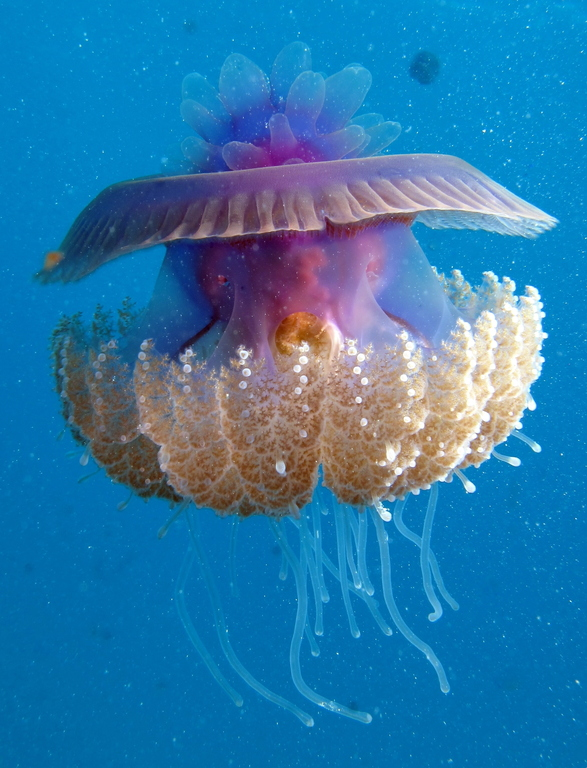
The Cauliflower Jelly, Cephea cephea. [Image source]
It does turn out, however, that the story is considerably more complicated than the media is making it out to be. (Though isn't that often the case?) Whether global sea jelly populations are increasing is actually thought to be the wrong question entirely by many jellies researchers. To them, the question itself is based in an incomprehension of jellies- it's treating them as though they are a single thing, rather than a huge and complex group of animals that fit into a wide variety of roles niches in many different aquatic ecosystems.
That being said, everyone does agree that human activity is having a huge effect on sea jellies. The story is much, much more difficult to parse than many other species, though. First off, jellies don't have much in the way of a fossil record. This is somewhat astonishing, since they are the world's oldest multi-organ animal. The few fossils we have found confirm that jellyfish predate the Cambrian explosion, dating back a minimum of 500 million years, possibly as much as 700 million years. Thanks to their complete lack of hard parts, however, they're very rarely fossilized. They most commonly appear in lagerstatten, fossil deposits that preserve animal soft parts in an anoxic environment. Fossil deposits are important for their ability to help us predict the fate of modern organisms. Comparisons of evolutionary strategies and population distributions of fossils from upheaval filled ancient times can give us valuable insight into modern life's reactions to change.
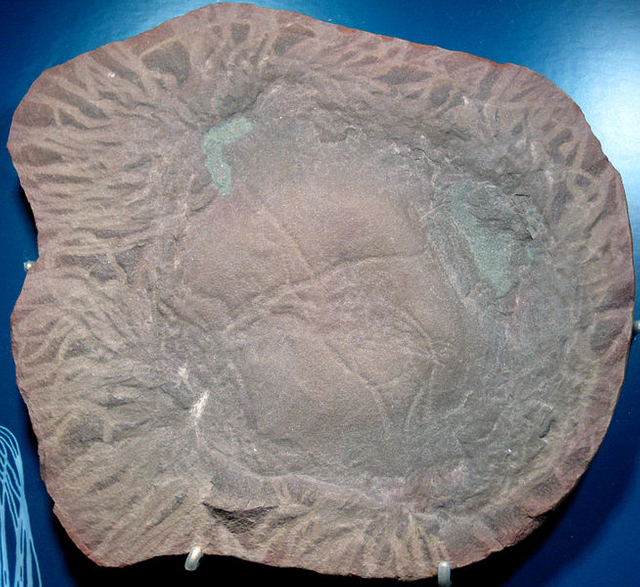
Anthracomedusa turnbulli fossil, a rare example of a jellyfish fossil. Found in a coal mine/lagerstatten in Illinois dating back the the Carboniferous. [Image source]
As if that weren't enough, however, there are a lot of unanswered questions about the lifecycle of the jellyfish. There are five stages to the lifecycle of the jellyfish. The planula, the polyp, the strobila, the ephyra, and finally the medusa. Each is remarkably different in morphology, lifestyle, and ecological niche. Jellyfish medusa (what we think of when we think of jellyfish) are relatively easy to track compared to the others. The polyps, a stage of the jellyfish lifestyle that involves them planting themselves on the ground and growing like stalked plants, are surprisingly hard to find. We have literally no idea where many sea jelly species grow as polyps. Because of this, we have a lot of trouble predicting when we're going to see massive bursts in sea jelly numbers.
On top of that, what we refer to as "jellyfish" actually include animals from multiple classes. They all fit into the phylum Cnidaria (named for their stinging cells, actually extremely complex cellular harpoons), but they're an extraordinarily diverse bunch. As if that didn't make classifications difficult enough, siphonophores, including the Portuguese man o' war, are often discussed as jellies, when while they are still still cnidarians, they are actually colonial organisms- each organ is actually an entirely separate organism. On top of that, there are comb jellies, which have split so far from the others that they're actually part of their own phylum, Ctenophora.
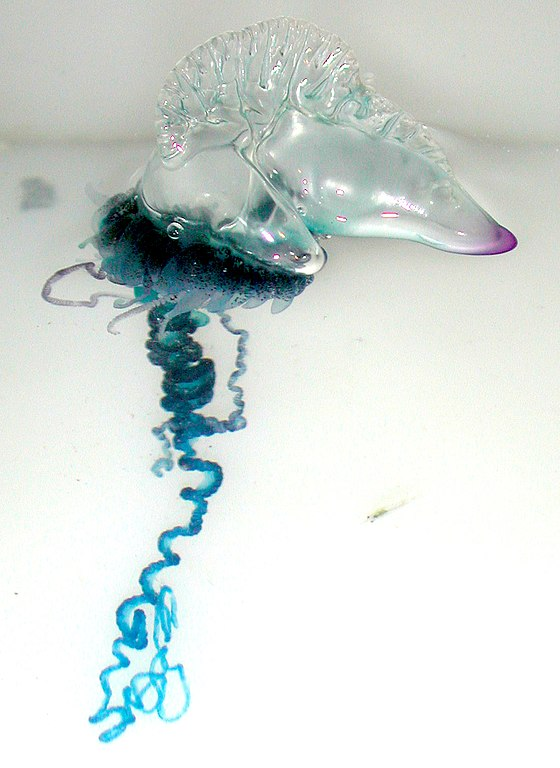
A Portuguese Man o' War, a siphonophore often confused for a sea jelly. [Image source]
Even for the notably complex field of marine ecology the study of sea jellies is challenging. There are some major ways that jellyfish are definitely being affected by human activity, however. First off, jellyfish are much more tolerant of dead zones than many other aquatic creatures. They're able to store large amounts of oxygen in their mesoglea- their jelly contained inside their tougher outsides- as well as remarkably regulating their internal chemistry, which is a big part of how they float. Thanks to this, they can thrive in the oxygen poor conditions of algal bloom related dead zones, eating the abundant plankton. When the dead zone retreats, the jellyfish remain, making it extremely difficult for fish and other organisms to recolonize the area.
Jellyfish are also very, very easily transported in ballast water, especially in their planula form. This has resulting in many jellyies becoming extremely effective invasive species. One example of this is Mnemiopsis leidyi's invasion of the Black Sea. Mnemiopsis leidyi, a comb jelly, was originally native to North America. It was introduced to the Black Sea via cargo ship ballast water in 1982. It probably only took a single Mnemiopsis leidyi, since it's a hermaphrodite, rather than being divided into males and females like Cnidarian medusa jellies. Hermaphroditic comb jellies can release over 10,000 eggs in a single day, without risking the genetic abnormalities of inbreeding somehow.
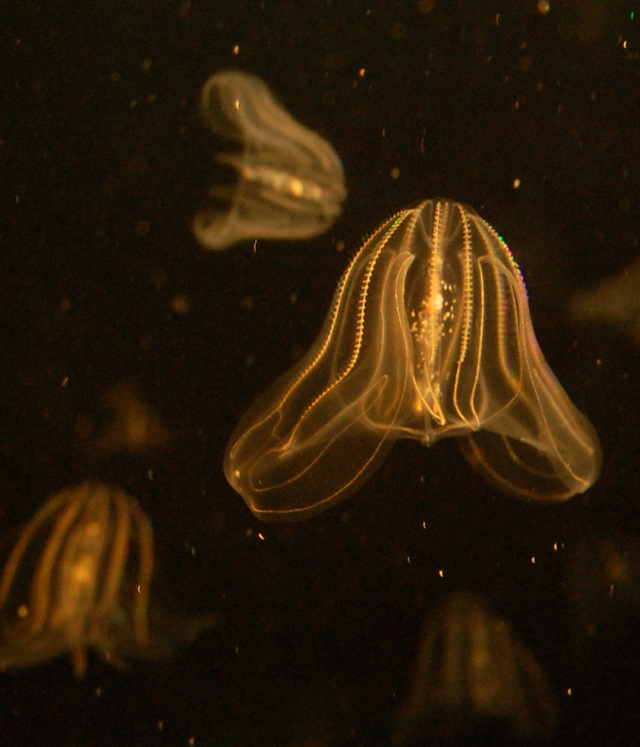
Mnemiopsis leidyi, the devastator of the Black Sea. It's also known as the Sea Walnut. They grow to a full inch across.[Image source]
Since there were no natural predators for Mnemiopsis leidyi in the Black Sea, salinity levels were just right, and the Black Sea was going through a warm period, the comb jelly population skyrocketed. Scientists estimated the Mnemiopsis leidyi in the Black sea to mass over half a million tons in 1989. This caused the fishery industries in the Black sea to completely collapse. In 1988 Black Sea fish landings reached 800,000 tons. In 1989 Black Sea fish landings had dropped to 66,000 tons. The comb jellies were completely destroying the Black Sea food chain the fish were depending on, starving them to death. The anchovy fishery in the Black sea saw a 98% drop in profits. The problem was eventually solved, however. While scientists debated whether to introduce Beroe ovata, Mnemiopsis leidyi's natural predator, to the Black Sea, Beroe ovata, a cnidarian that exclusively feeds on ctenophores, managed to smuggle itself over to the Black Sea in ballast water itself. This is one of the rare examples of one invasive species solving another invasive species problem without causing a ton of other problems. We can't count on further sea jelly invasions solving themselves. In Namibian waters, for instance, the combined weight of jellies is three times that of fish, thanks to some severe dead zones giving the jellies a chance to take over. Even after the retreat of the dead zones, however, the jellies remained dominant in the region- an ominous sign.
The immense blooms of sea jellies that have started appearing around the world have been accelerated by another factor, as well. Severe overfishing has heavily overwhelmed a lot of the natural fish predators of jellies, allowing them to swell massively in population.
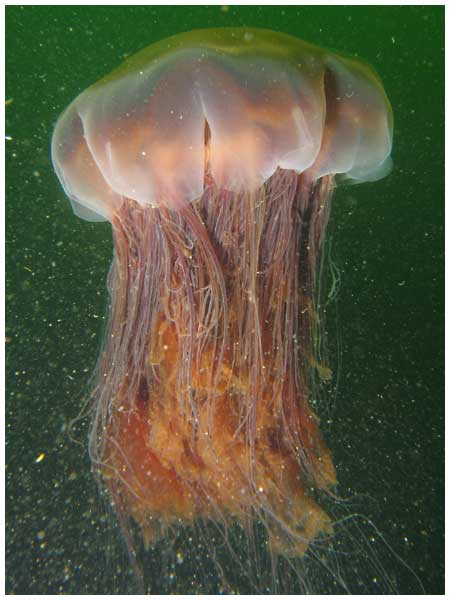
The Lion's Mane jelly, the single largest species of sea jelly. It can grow 8 feet wide with tentacles 120 feet long. [Image source]
Sea jellies are causing huge amounts of problems right now. The huge jelly blooms are frequently the cause of mechanical failures. They've been sucked into water intakes, clogging and shutting down power plants, desalination plants, and ship engines. Jellies frequently shut down beaches. Most importantly, the fact that they're being less harmed- or even thriving- under the human assault on the oceans is radically altering evolutionary conditions in the oceans. We might be giving the seas back to jellies after hundreds of millions of years of vertebrate domination.
Bibliography:
- Spineless: The Science of Jellyfish and the Art of Growing a Backbone, by Juli Berwald
- The Ocean of Life: The Fate of Man and the Sea, by Callum Roberts
- https://www.sciencedaily.com/releases/2007/10/071030211210.htm
- https://en.wikipedia.org/wiki/Jellyfish
- https://en.wikipedia.org/wiki/Portuguese_man_o%27_war
- https://en.wikipedia.org/wiki/Scyphozoa
- https://en.wikipedia.org/wiki/Ctenophora
I'll definitely be returning to sea jellies in future posts, they're too interesting not to write more about!

Being A SteemStem Member
You received a 80.0% upvote since you are a member of geopolis and wrote in the category of "ecology".
To read more about us and what we do, click here.
https://steemit.com/geopolis/@geopolis/geopolis-the-community-for-global-sciences-update-4
Great addition to this series. The Mnemiopsis leidyi's/Beroe ovata story was particularly cool. I never knew of an instance when one invasive species killed off another.
It does happen every now and then! Usually, though, they target a number of native species as well. This was an unusually happy story.
And so we return unto the Void. The entire jellyfish situation is reminiscent of Faust book 2. Mephisto contemptuously laughs at Faust's decades long technical struggle to "reclaim" land from the ocean. "All these will return to the ocean," or something like that, when Mephisto takes Faust's soul. In a sense, maybe Goethe may have predicted man's ultimate end, as his technical marvels give way to the ancients of the depths, reclaiming creation after a blink of time eternal, from deluded and arrogant man.
Man, I really need to read Faust. I've got a copy sitting in my to read pile right now. I might reread The Sorrows of Young Werther first, though.
Book one was interesting. Book two shockingly disappointing, but understandable ending, as how does one conceptualize redemption of a man who sold his soul to the devil other than resorting to deus ex machina?
With extreme difficulty, to say the least.
As usual, your post is great and fleshy. Just keep on posting lad Im following.
I definitely will!
This is such a well written series, congrats @mountainwashere. And thank you for this awesome series full of #TIL info!
I'm glad you enjoy it!
As far as my knowledge on jellyfish can reach, these animals are also the one of the main food sources of our marine turtles. Since there is an unprecedented abundance of jellyfish in the ocean enough to threaten other populations of ocean inhabitants, do you think it would be a natural solution if turtles are also present where these jellies thrive?
Normally yes, but human activity, climate change, and invasive species spread by humans are posing major threats to turtle eggs, so despite their rapidly increasing food supply turtle numbers are still dropping drastically.
You're right. 😔 Turtles face a problem of their own too and it's not even about food but disruption of a generation in their life cycle. Anyway, do you know any way jellyfishes can be beneficial to humans?
We can eat them! Many jellyfish species are super high in protein. They don't really have much of a taste, but they provide excellent texture to dishes.
Is that so? Now I learned something new. Haha All along I thought jellyfish are just 95% water. That's a big chunk so I assumed there's nothing more to it than water. 😅
They are mostly water- the rest is just protein!
Like we've discussed previously on one of your older posts, overfishing is one of the biggest issues that face our oceans besides climate change.
I may as well stay out of the ocean at this point, I get stung by a jellyfish 7 times out of 10 that I get in... This is only going to increase that. :/
Another excellent post, man. Keep it up.
They've been developing some really excellent anti-jellyfish sting cream lately, it's supposed to be hitting shelves soon if it hasn't already!
I love water bodies and aquatic animal, thank yoi for sharing the wonderful post and photos
Your Post Has Been Featured on @Resteemable!
Feature any Steemit post using resteemit.com!
How It Works:
1. Take Any Steemit URL
2. Erase
https://3. Type
reGet Featured Instantly � Featured Posts are voted every 2.4hrs
Join the Curation Team Here | Vote Resteemable for Witness